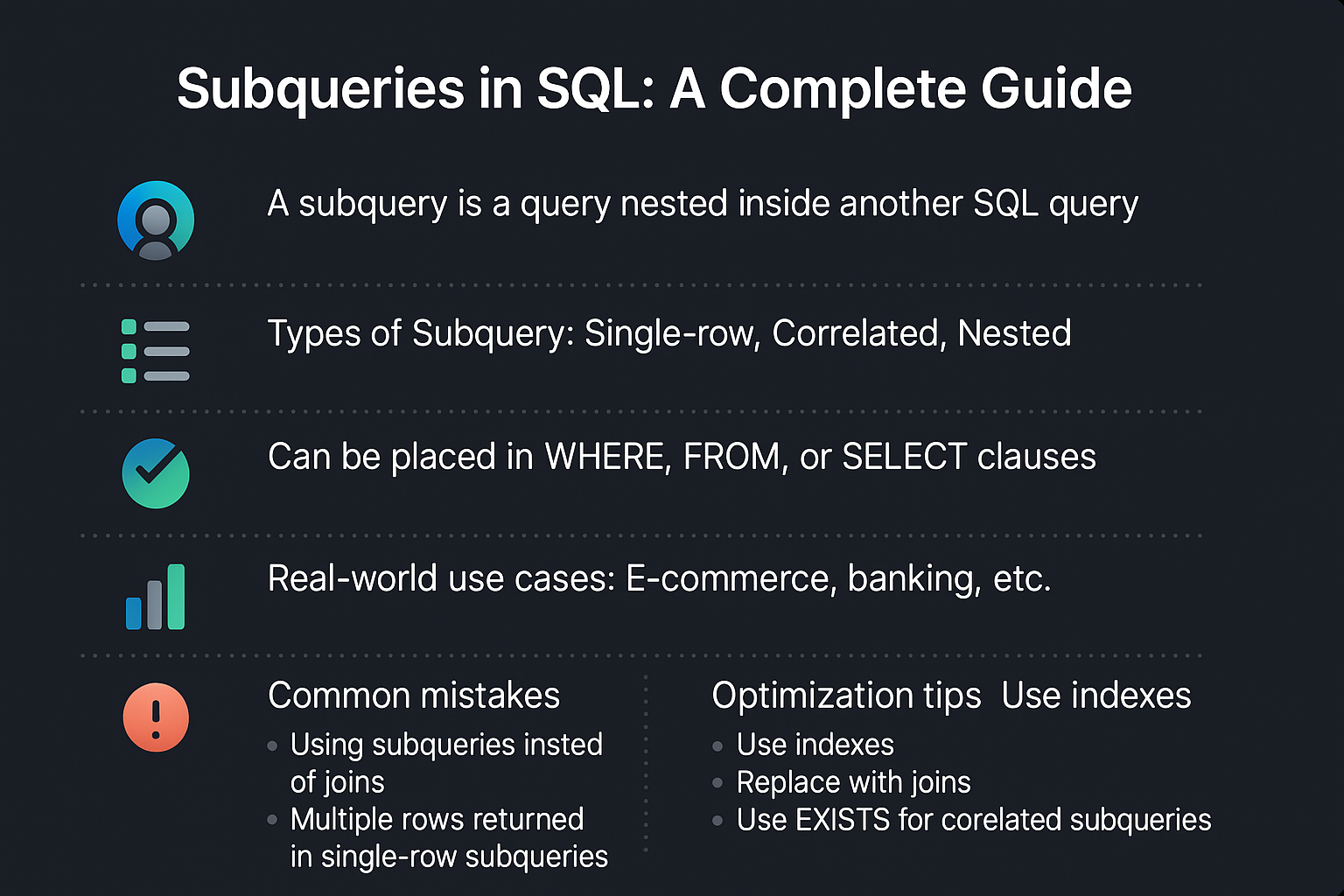Introduction
A subquery (also known as a nested query or inner query) is a query inside another SQL query. Subqueries are used to perform complex filtering, aggregations, and dynamic comparisons in a single statement.
Why Subqueries Matter
- Enable dynamic conditions based on query results.
- Simplify complex SQL logic by breaking it into parts.
- Essential for analytics, reporting, and application development.
Real-world analogy:
Think of a subquery as asking a follow-up question to your main question. For example, “Who are the top 5 customers?” requires first finding the top 5 orders (subquery) and then retrieving the customers (main query).
Core Concepts
Types of Subqueries
- Single-Row Subquery: Returns one value.
- Multi-Row Subquery: Returns multiple values.
- Correlated Subquery: References columns from the outer query.
- Nested Subquery: A subquery inside another subquery.
Subquery Placement
- In
WHEREclauses for filtering. - In
FROMclauses as derived tables. - In
SELECTclauses for calculated fields.
SQL Examples
Single-Row Subquery
SELECT name, email
FROM customers
WHERE customer_id = (
SELECT customer_id FROM orders ORDER BY amount DESC LIMIT 1
);
Multi-Row Subquery with IN
SELECT name
FROM customers
WHERE customer_id IN (
SELECT customer_id FROM orders WHERE amount > 500
);
Correlated Subquery
SELECT c.name, c.email
FROM customers c
WHERE EXISTS (
SELECT 1 FROM orders o WHERE o.customer_id = c.customer_id AND o.amount > 1000
);
Subquery in SELECT
SELECT name,
(SELECT COUNT(*) FROM orders o WHERE o.customer_id = c.customer_id) AS order_count
FROM customers c;
Real-World Use Cases
- E-commerce: Identify customers with highest spending.
- Banking: Fetch accounts with balances above average.
- Analytics: Create dynamic rankings and top-N reports.
Common Mistakes and Anti-Patterns
- Using subqueries where JOINs are better: Can cause performance issues.
- Returning multiple rows in single-row subqueries: Leads to errors.
- Correlated subqueries on large datasets: Can be very slow.
Performance and Scalability Implications
- Subqueries can be slower than joins; use EXPLAIN to analyze.
- Correlated subqueries execute per row, impacting performance on large tables.
- Derived tables (subqueries in FROM) can simplify complex queries but may use more memory.
RDBMS Comparison
| Feature | PostgreSQL | MySQL | Oracle |
|---|---|---|---|
| Correlated Subqueries | Fully supported | Fully supported | Fully supported |
| LIMIT in Subquery | Supported | Supported | Use ROWNUM/FETCH |
| Subquery in FROM | Fully supported | Fully supported | Fully supported |
Best Practices & Optimization Tips
- Use indexes on columns used in subquery conditions.
- Replace subqueries with JOINs when appropriate.
- Use EXISTS instead of IN for correlated checks.
- Cache results or use CTEs for repeated subqueries.
When to Use vs When to Avoid
Use Subqueries When:
- You need dynamic filtering based on query results.
- Breaking complex logic into manageable parts.
Avoid Subqueries When:
- Simple joins or aggregations can achieve the same result.
- Large correlated subqueries impact performance.
Conclusion & Key Takeaways
Subqueries are a powerful SQL tool for complex queries. Proper use and optimization can simplify logic and enable dynamic data retrieval.
Key Points:
- Subqueries can be single-row, multi-row, or correlated.
- Optimize with indexes and consider joins for performance.
- Use CTEs for readability in complex nested queries.
FAQ
1. What is a subquery in SQL?
A query nested inside another SQL query.
2. Can I use subqueries in SELECT?
Yes, for calculated fields or aggregations.
3. What’s the difference between subquery and join?
Joins combine tables; subqueries embed queries inside others.
4. What is a correlated subquery?
A subquery that references columns from the outer query.
5. Are subqueries slower than joins?
Often yes, but depends on the use case and indexes.
6. Can subqueries return multiple columns?
Yes, especially in the FROM clause as derived tables.
7. How do I optimize subqueries?
Use indexes, limit rows, and consider rewriting as joins or CTEs.
8. Can I nest subqueries?
Yes, you can have multiple levels of nested subqueries.
9. Are subqueries standard across RDBMS?
Yes, with minor syntax differences (e.g., Oracle ROWNUM).
10. Should I use CTEs instead of subqueries?
For complex logic, CTEs improve readability and maintainability.
